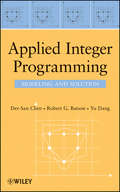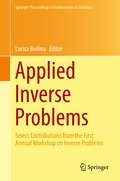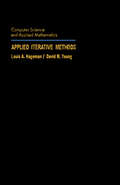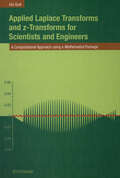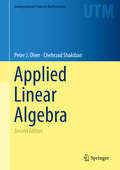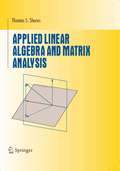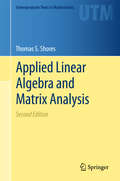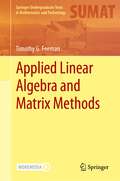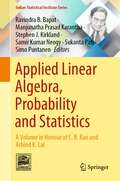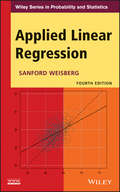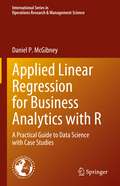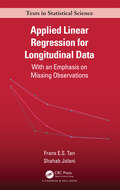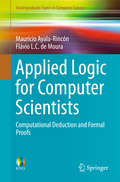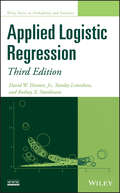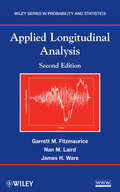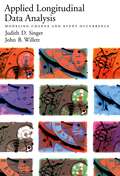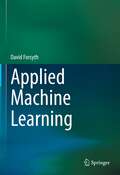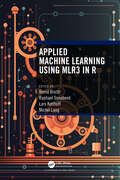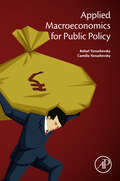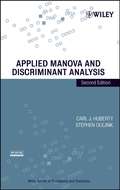- Table View
- List View
Applied Integer Programming: Modeling and Solution
by Der-San Chen Robert G. Batson Yu DangAn accessible treatment of the modeling and solution of integer programming problems, featuring modern applications and software In order to fully comprehend the algorithms associated with integer programming, it is important to understand not only how algorithms work, but also why they work. Applied Integer Programming features a unique emphasis on this point, focusing on problem modeling and solution using commercial software. Taking an application-oriented approach, this book addresses the art and science of mathematical modeling related to the mixed integer programming (MIP) framework and discusses the algorithms and associated practices that enable those models to be solved most efficiently. The book begins with coverage of successful applications, systematic modeling procedures, typical model types, transformation of non-MIP models, combinatorial optimization problem models, and automatic preprocessing to obtain a better formulation. Subsequent chapters present algebraic and geometric basic concepts of linear programming theory and network flows needed for understanding integer programming. Finally, the book concludes with classical and modern solution approaches as well as the key components for building an integrated software system capable of solving large-scale integer programming and combinatorial optimization problems. Throughout the book, the authors demonstrate essential concepts through numerous examples and figures. Each new concept or algorithm is accompanied by a numerical example, and, where applicable, graphics are used to draw together diverse problems or approaches into a unified whole. In addition, features of solution approaches found in today's commercial software are identified throughout the book. Thoroughly classroom-tested, Applied Integer Programming is an excellent book for integer programming courses at the upper-undergraduate and graduate levels. It also serves as a well-organized reference for professionals, software developers, and analysts who work in the fields of applied mathematics, computer science, operations research, management science, and engineering and use integer-programming techniques to model and solve real-world optimization problems.
Applied Inverse Problems: Select Contributions from the First Annual Workshop on Inverse Problems (Springer Proceedings in Mathematics & Statistics #48)
by Larisa BeilinaThis proceedings volume is based on papers presented at the First Annual Workshop on Inverse Problems which was held in June 2011 at the Department of Mathematics, Chalmers University of Technology. The purpose of the workshop was to present new analytical developments and numerical methods for solutions of inverse problems. State-of-the-art and future challenges in solving inverse problems for a broad range of applications was also discussed. The contributions in this volume are reflective of these themes and will be beneficial to researchers in this area.
Applied Laplace Transforms and z-Transforms for Scientists and Engineers: A Computational Approach using a Mathematica Package
by Urs GrafThe theory of Laplace transformation is an important part of the mathematical background required for engineers, physicists and mathematicians. Laplace transformation methods provide easy and effective techniques for solving many problems arising in various fields of science and engineering, especially for solving differential equations. What the Laplace transformation does in the field of differential equations, the z-transformation achieves for difference equations. The two theories are parallel and have many analogies. Laplace and z transformations are also referred to as operational calculus, but this notion is also used in a more restricted sense to denote the operational calculus of Mikusinski. This book does not use the operational calculus of Mikusinski, whose approach is based on abstract algebra and is not readily accessible to engineers and scientists. The symbolic computation capability of Mathematica can now be used in favor of the Laplace and z-transformations. The first version of the Mathematica Package LaplaceAndzTransforrns developed by the author appeared ten years ago. The Package computes not only Laplace and z-transforms but also includes many routines from various domains of applications. Upon loading the Package, about one hundred and fifty new commands are added to the built-in commands of Mathematica. The code is placed in front of the already built-in code of Laplace and z-transformations of Mathematica so that built-in functions not covered by the Package remain available. The Package substantially enhances the Laplace and z-transformation facilities of Mathematica. The book is mainly designed for readers working in the field of applications.
Applied Linear Algebra (Undergraduate Texts in Mathematics)
by Peter J. Olver Chehrzad ShakibanThis textbook develops the essential tools of linear algebra, with the goal of imparting technique alongside contextual understanding. Applications go hand-in-hand with theory, each reinforcing and explaining the other. This approach encourages students to develop not only the technical proficiency needed to go on to further study, but an appreciation for when, why, and how the tools of linear algebra can be used across modern applied mathematics.Providing an extensive treatment of essential topics such as Gaussian elimination, inner products and norms, and eigenvalues and singular values, this text can be used for an in-depth first course, or an application-driven second course in linear algebra. In this second edition, applications have been updated and expanded to include numerical methods, dynamical systems, data analysis, and signal processing, while the pedagogical flow of the core material has been improved. Throughout, the text emphasizes the conceptual connections between each application and the underlying linear algebraic techniques, thereby enabling students not only to learn how to apply the mathematical tools in routine contexts, but also to understand what is required to adapt to unusual or emerging problems.No previous knowledge of linear algebra is needed to approach this text, with single-variable calculus as the only formal prerequisite. However, the reader will need to draw upon some mathematical maturity to engage in the increasing abstraction inherent to the subject. Once equipped with the main tools and concepts from this book, students will be prepared for further study in differential equations, numerical analysis, data science and statistics, and a broad range of applications. The first author’s text, Introduction to Partial Differential Equations, is an ideal companion volume, forming a natural extension of the linear mathematical methods developed here.
Applied Linear Algebra and Matrix Analysis (Undergraduate Texts in Mathematics)
by Thomas S. ShoresThis new book offers a fresh approach to matrix and linear algebra by providing a balanced blend of applications, theory, and computation, while highlighting their interdependence. Intended for a one-semester course, Applied Linear Algebra and Matrix Analysis places special emphasis on linear algebra as an experimental science, with numerous examples, computer exercises, and projects. While the flavor is heavily computational and experimental, the text is independent of specific hardware or software platforms. Throughout the book, significant motivating examples are woven into the text, and each section ends with a set of exercises.
Applied Linear Algebra and Matrix Analysis (Undergraduate Texts in Mathematics)
by Thomas S. ShoresThis new book offers a fresh approach to matrix and linear algebra by providing a balanced blend of applications, theory, and computation, while highlighting their interdependence. Intended for a one-semester course, Applied Linear Algebra and Matrix Analysis places special emphasis on linear algebra as an experimental science, with numerous examples, computer exercises, and projects. While the flavor is heavily computational and experimental, the text is independent of specific hardware or software platforms. Throughout the book, significant motivating examples are woven into the text, and each section ends with a set of exercises.
Applied Linear Algebra and Matrix Methods (Springer Undergraduate Texts in Mathematics and Technology)
by Timothy G. FeemanThis textbook is designed for a first course in linear algebra for undergraduate students from a wide range of quantitative and data driven fields. By focusing on applications and implementation, students will be prepared to go on to apply the power of linear algebra in their own discipline. With an ever-increasing need to understand and solve real problems, this text aims to provide a growing and diverse group of students with an applied linear algebra toolkit they can use to successfully grapple with the complex world and the challenging problems that lie ahead. Applications such as least squares problems, information retrieval, linear regression, Markov processes, finding connections in networks, and more, are introduced on a small scale as early as possible and then explored in more generality as projects. Additionally, the book draws on the geometry of vectors and matrices as the basis for the mathematics, with the concept of orthogonality taking center stage. Important matrix factorizations as well as the concepts of eigenvalues and eigenvectors emerge organically from the interplay between matrix computations and geometry.The R files are extra and freely available. They include basic code and templates for many of the in-text examples, most of the projects, and solutions to selected exercises. As much as possible, data sets and matrix entries are included in the files, thus reducing the amount of manual data entry required.
Applied Linear Algebra, Probability and Statistics: A Volume in Honour of C. R. Rao and Arbind K. Lal (Indian Statistical Institute Series)
by Ravindra B. Bapat Manjunatha Prasad Karantha Stephen J. Kirkland Samir Kumar Neogy Sukanta Pati Simo PuntanenThis book focuses on research in linear algebra, statistics, matrices, graphs and their applications. Many chapters in the book feature new findings due to applications of matrix and graph methods. The book also discusses rediscoveries of the subject by using new methods. Dedicated to Prof. Calyampudi Radhakrishna Rao (C.R. Rao) who has completed 100 years of legendary life and continues to inspire us all and Prof. Arbind K. Lal who has sadly departed us too early, it has contributions from collaborators, students, colleagues and admirers of Professors Rao and Lal. With many chapters on generalized inverses, matrix analysis, matrices and graphs, applied probability and statistics, and the history of ancient mathematics, this book offers a diverse array of mathematical results, techniques and applications. The book promises to be especially rewarding for readers with an interest in the focus areas of applied linear algebra, probability and statistics.
Applied Linear Regression (Wiley Series in Probability and Statistics)
by Sanford WeisbergPraise for the Third Edition "...this is an excellent book which could easily be used as a course text..." —International Statistical Institute The Fourth Edition of Applied Linear Regression provides a thorough update of the basic theory and methodology of linear regression modeling. Demonstrating the practical applications of linear regression analysis techniques, the Fourth Edition uses interesting, real-world exercises and examples. Stressing central concepts such as model building, understanding parameters, assessing fit and reliability, and drawing conclusions, the new edition illustrates how to develop estimation, confidence, and testing procedures primarily through the use of least squares regression. While maintaining the accessible appeal of each previous edition,Applied Linear Regression, Fourth Edition features: Graphical methods stressed in the initial exploratory phase, analysis phase, and summarization phase of an analysis In-depth coverage of parameter estimates in both simple and complex models, transformations, and regression diagnostics Newly added material on topics including testing, ANOVA, and variance assumptions Updated methodology, such as bootstrapping, cross-validation binomial and Poisson regression, and modern model selection methods Applied Linear Regression, Fourth Edition is an excellent textbook for upper-undergraduate and graduate-level students, as well as an appropriate reference guide for practitioners and applied statisticians in engineering, business administration, economics, and the social sciences.
Applied Linear Regression (Wiley Series in Probability and Statistics)
by Sanford WeisbergPraise for the Third Edition "...this is an excellent book which could easily be used as a course text..." —International Statistical Institute The Fourth Edition of Applied Linear Regression provides a thorough update of the basic theory and methodology of linear regression modeling. Demonstrating the practical applications of linear regression analysis techniques, the Fourth Edition uses interesting, real-world exercises and examples. Stressing central concepts such as model building, understanding parameters, assessing fit and reliability, and drawing conclusions, the new edition illustrates how to develop estimation, confidence, and testing procedures primarily through the use of least squares regression. While maintaining the accessible appeal of each previous edition,Applied Linear Regression, Fourth Edition features: Graphical methods stressed in the initial exploratory phase, analysis phase, and summarization phase of an analysis In-depth coverage of parameter estimates in both simple and complex models, transformations, and regression diagnostics Newly added material on topics including testing, ANOVA, and variance assumptions Updated methodology, such as bootstrapping, cross-validation binomial and Poisson regression, and modern model selection methods Applied Linear Regression, Fourth Edition is an excellent textbook for upper-undergraduate and graduate-level students, as well as an appropriate reference guide for practitioners and applied statisticians in engineering, business administration, economics, and the social sciences.
Applied Linear Regression for Business Analytics with R: A Practical Guide to Data Science with Case Studies (International Series in Operations Research & Management Science #337)
by Daniel P. McGibneyApplied Linear Regression for Business Analytics with R introduces regression analysis to business students using the R programming language with a focus on illustrating and solving real-time, topical problems. Specifically, this book presents modern and relevant case studies from the business world, along with clear and concise explanations of the theory, intuition, hands-on examples, and the coding required to employ regression modeling. Each chapter includes the mathematical formulation and details of regression analysis and provides in-depth practical analysis using the R programming language.
Applied Linear Regression for Longitudinal Data: With an Emphasis on Missing Observations (Chapman & Hall/CRC Texts in Statistical Science)
by Frans E.S. Tan Shahab JolaniThis book introduces best practices in longitudinal data analysis at intermediate level, with a minimum number of formulas without sacrificing depths. It meets the need to understand statistical concepts of longitudinal data analysis by visualizing important techniques instead of using abstract mathematical formulas. Different solutions such as multiple imputation are explained conceptually and consequences of missing observations are clarified using visualization techniques. Key features include the following: • Provides datasets and examples online • Gives state-of-the-art methods of dealing with missing observations in a non-technical way with a special focus on sensitivity analysis • Conceptualises the analysis of comparative (experimental and observational) studies It is the ideal companion for researcher and students in epidemiological, health, and social and behavioral sciences working with longitudinal studies without a mathematical background. Frans E.S. Tan is an associate professor (retired) of methodology and statisticsat Maastricht University, The Netherlands. Shahab Jolani is an assistant professor of methodology and statistics atMaastricht University, The Netherlands.
Applied Linear Regression for Longitudinal Data: With an Emphasis on Missing Observations (Chapman & Hall/CRC Texts in Statistical Science)
by Frans E.S. Tan Shahab JolaniThis book introduces best practices in longitudinal data analysis at intermediate level, with a minimum number of formulas without sacrificing depths. It meets the need to understand statistical concepts of longitudinal data analysis by visualizing important techniques instead of using abstract mathematical formulas. Different solutions such as multiple imputation are explained conceptually and consequences of missing observations are clarified using visualization techniques. Key features include the following: • Provides datasets and examples online • Gives state-of-the-art methods of dealing with missing observations in a non-technical way with a special focus on sensitivity analysis • Conceptualises the analysis of comparative (experimental and observational) studies It is the ideal companion for researcher and students in epidemiological, health, and social and behavioral sciences working with longitudinal studies without a mathematical background. Frans E.S. Tan is an associate professor (retired) of methodology and statisticsat Maastricht University, The Netherlands. Shahab Jolani is an assistant professor of methodology and statistics atMaastricht University, The Netherlands.
Applied Logic for Computer Scientists: Computational Deduction and Formal Proofs (Undergraduate Topics in Computer Science)
by Mauricio Ayala-Rincón Flávio L. de MouraThis book provides an introduction to logic and mathematical induction which are the basis of any deductive computational framework. A strong mathematical foundation of the logical engines available in modern proof assistants, such as the PVS verification system, is essential for computer scientists, mathematicians and engineers to increment their capabilities to provide formal proofs of theorems and to certify the robustness of software and hardware systems. The authors present a concise overview of the necessary computational and mathematical aspects of ‘logic’, placing emphasis on both natural deduction and sequent calculus. Differences between constructive and classical logic are highlighted through several examples and exercises. Without neglecting classical aspects of computational logic, the authors also highlight the connections between logical deduction rules and proof commands in proof assistants, presenting simple examples of formalizations of the correctness of algebraic functions and algorithms in PVS. Applied Logic for Computer Scientists will not only benefit students of computer science and mathematics but also software, hardware, automation, electrical and mechatronic engineers who are interested in the application of formal methods and the related computational tools to provide mathematical certificates of the quality and accuracy of their products and technologies.
Applied Logistic Regression (Wiley Series in Probability and Statistics)
by David W. Hosmer Jr. Stanley Lemeshow Rodney X. SturdivantA new edition of the definitive guide to logistic regression modeling for health science and other applications This thoroughly expanded Third Edition provides an easily accessible introduction to the logistic regression (LR) model and highlights the power of this model by examining the relationship between a dichotomous outcome and a set of covariables. Applied Logistic Regression, Third Edition emphasizes applications in the health sciences and handpicks topics that best suit the use of modern statistical software. The book provides readers with state-of-the-art techniques for building, interpreting, and assessing the performance of LR models. New and updated features include: A chapter on the analysis of correlated outcome data A wealth of additional material for topics ranging from Bayesian methods to assessing model fit Rich data sets from real-world studies that demonstrate each method under discussion Detailed examples and interpretation of the presented results as well as exercises throughout Applied Logistic Regression, Third Edition is a must-have guide for professionals and researchers who need to model nominal or ordinal scaled outcome variables in public health, medicine, and the social sciences as well as a wide range of other fields and disciplines.
Applied Logistic Regression (Wiley Series in Probability and Statistics #398)
by Stanley Lemeshow David W. Hosmer Jr. Rodney X. SturdivantA new edition of the definitive guide to logistic regression modeling for health science and other applications This thoroughly expanded Third Edition provides an easily accessible introduction to the logistic regression (LR) model and highlights the power of this model by examining the relationship between a dichotomous outcome and a set of covariables. Applied Logistic Regression, Third Edition emphasizes applications in the health sciences and handpicks topics that best suit the use of modern statistical software. The book provides readers with state-of-the-art techniques for building, interpreting, and assessing the performance of LR models. New and updated features include: A chapter on the analysis of correlated outcome data A wealth of additional material for topics ranging from Bayesian methods to assessing model fit Rich data sets from real-world studies that demonstrate each method under discussion Detailed examples and interpretation of the presented results as well as exercises throughout Applied Logistic Regression, Third Edition is a must-have guide for professionals and researchers who need to model nominal or ordinal scaled outcome variables in public health, medicine, and the social sciences as well as a wide range of other fields and disciplines.
Applied Longitudinal Analysis (Wiley Series in Probability and Statistics #998)
by Garrett M. Fitzmaurice Nan M. Laird James H. WarePraise for the First Edition ". . . [this book] should be on the shelf of everyone interested in . . . longitudinal data analysis." —Journal of the American Statistical Association Features newly developed topics and applications of the analysis of longitudinal data Applied Longitudinal Analysis, Second Edition presents modern methods for analyzing data from longitudinal studies and now features the latest state-of-the-art techniques. The book emphasizes practical, rather than theoretical, aspects of methods for the analysis of diverse types of longitudinal data that can be applied across various fields of study, from the health and medical sciences to the social and behavioral sciences. The authors incorporate their extensive academic and research experience along with various updates that have been made in response to reader feedback. The Second Edition features six newly added chapters that explore topics currently evolving in the field, including: Fixed effects and mixed effects models Marginal models and generalized estimating equations Approximate methods for generalized linear mixed effects models Multiple imputation and inverse probability weighted methods Smoothing methods for longitudinal data Sample size and power Each chapter presents methods in the setting of applications to data sets drawn from the health sciences. New problem sets have been added to many chapters, and a related website features sample programs and computer output using SAS, Stata, and R, as well as data sets and supplemental slides to facilitate a complete understanding of the material. With its strong emphasis on multidisciplinary applications and the interpretation of results, Applied Longitudinal Analysis, Second Edition is an excellent book for courses on statistics in the health and medical sciences at the upper-undergraduate and graduate levels. The book also serves as a valuable reference for researchers and professionals in the medical, public health, and pharmaceutical fields as well as those in social and behavioral sciences who would like to learn more about analyzing longitudinal data.
Applied Longitudinal Data Analysis: Modeling Change and Event Occurrence
by Judith D. Singer John B. WillettChange is constant in everyday life. Infants crawl and then walk, children learn to read and write, teenagers mature in myriad ways, the elderly become frail and forgetful. Beyond these natural processes and events, external forces and interventions instigate and disrupt change: test scores may rise after a coaching course, drug abusers may remain abstinent after residential treatment. By charting changes over time and investigating whether and when events occur, researchers reveal the temporal rhythms of our lives. Applied Longitudinal Data Analysis is a much-needed professional book for empirical researchers and graduate students in the behavioral, social, and biomedical sciences. It offers the first accessible in-depth presentation of two of today's most popular statistical methods: multilevel models for individual change and hazard/survival models for event occurrence (in both discrete- and continuous-time). Using clear, concise prose and real data sets from published studies, the authors take you step by step through complete analyses, from simple exploratory displays that reveal underlying patterns through sophisticated specifications of complex statistical models. Applied Longitudinal Data Analysis offers readers a private consultation session with internationally recognized experts and represents a unique contribution to the literature on quantitative empirical methods. Visit http://www.ats.ucla.edu/stat/examples/alda.htm for: · Downloadable data sets · Library of computer programs in SAS, SPSS, Stata, HLM, MLwiN, and more · Additional material for data analysis
Applied Longitudinal Data Analysis: Modeling Change and Event Occurrence
by Judith D. Singer John B. WillettChange is constant in everyday life. Infants crawl and then walk, children learn to read and write, teenagers mature in myriad ways, the elderly become frail and forgetful. Beyond these natural processes and events, external forces and interventions instigate and disrupt change: test scores may rise after a coaching course, drug abusers may remain abstinent after residential treatment. By charting changes over time and investigating whether and when events occur, researchers reveal the temporal rhythms of our lives. Applied Longitudinal Data Analysis is a much-needed professional book for empirical researchers and graduate students in the behavioral, social, and biomedical sciences. It offers the first accessible in-depth presentation of two of today's most popular statistical methods: multilevel models for individual change and hazard/survival models for event occurrence (in both discrete- and continuous-time). Using clear, concise prose and real data sets from published studies, the authors take you step by step through complete analyses, from simple exploratory displays that reveal underlying patterns through sophisticated specifications of complex statistical models. Applied Longitudinal Data Analysis offers readers a private consultation session with internationally recognized experts and represents a unique contribution to the literature on quantitative empirical methods. Visit http://www.ats.ucla.edu/stat/examples/alda.htm for: · Downloadable data sets · Library of computer programs in SAS, SPSS, Stata, HLM, MLwiN, and more · Additional material for data analysis
Applied Machine Learning
by David ForsythMachine learning methods are now an important tool for scientists, researchers, engineers and students in a wide range of areas. This book is written for people who want to adopt and use the main tools of machine learning, but aren’t necessarily going to want to be machine learning researchers. Intended for students in final year undergraduate or first year graduate computer science programs in machine learning, this textbook is a machine learning toolkit. Applied Machine Learning covers many topics for people who want to use machine learning processes to get things done, with a strong emphasis on using existing tools and packages, rather than writing one’s own code.A companion to the author's Probability and Statistics for Computer Science, this book picks up where the earlier book left off (but also supplies a summary of probability that the reader can use).Emphasizing the usefulness of standard machinery from applied statistics, this textbook gives an overview of the major applied areas in learning, including coverage of:• classification using standard machinery (naive bayes; nearest neighbor; SVM)• clustering and vector quantization (largely as in PSCS)• PCA (largely as in PSCS)• variants of PCA (NIPALS; latent semantic analysis; canonical correlation analysis)• linear regression (largely as in PSCS)• generalized linear models including logistic regression• model selection with Lasso, elasticnet• robustness and m-estimators• Markov chains and HMM’s (largely as in PSCS)• EM in fairly gory detail; long experience teaching this suggests one detailed example is required, which students hate; but once they’ve been through that, the next one is easy• simple graphical models (in the variational inference section)• classification with neural networks, with a particular emphasis onimage classification• autoencoding with neural networks• structure learning
Applied Machine Learning Using mlr3 in R
by Bernd Bischl Raphael Sonabend Lars Kotthoff Michel Langmlr3 is an award-winning ecosystem of R packages that have been developed to enable state-of-the-art machine learning capabilities in R. Applied Machine Learning Using mlr3 in R gives an overview of flexible and robust machine learning methods, with an emphasis on how to implement them using mlr3 in R. It covers various key topics, including basic machine learning tasks, such as building and evaluating a predictive model; hyperparameter tuning of machine learning approaches to obtain peak performance; building machine learning pipelines that perform complex operations such as pre-processing followed by modelling followed by aggregation of predictions; and extending the mlr3 ecosystem with custom learners, measures, or pipeline components. Features: In-depth coverage of the mlr3 ecosystem for users and developers Explanation and illustration of basic and advanced machine learning concepts Ready to use code samples that can be adapted by the user for their application Convenient and expressive machine learning pipelining enabling advanced modelling Coverage of topics that are often ignored in other machine learning books The book is primarily aimed at researchers, practitioners, and graduate students who use machine learning or who are interested in using it. It can be used as a textbook for an introductory or advanced machine learning class that uses R, as a reference for people who work with machine learning methods, and in industry for exploratory experiments in machine learning.
Applied Machine Learning Using mlr3 in R
by Bernd Bischl Raphael Sonabend Lars Kotthoff Michel Langmlr3 is an award-winning ecosystem of R packages that have been developed to enable state-of-the-art machine learning capabilities in R. Applied Machine Learning Using mlr3 in R gives an overview of flexible and robust machine learning methods, with an emphasis on how to implement them using mlr3 in R. It covers various key topics, including basic machine learning tasks, such as building and evaluating a predictive model; hyperparameter tuning of machine learning approaches to obtain peak performance; building machine learning pipelines that perform complex operations such as pre-processing followed by modelling followed by aggregation of predictions; and extending the mlr3 ecosystem with custom learners, measures, or pipeline components. Features: In-depth coverage of the mlr3 ecosystem for users and developers Explanation and illustration of basic and advanced machine learning concepts Ready to use code samples that can be adapted by the user for their application Convenient and expressive machine learning pipelining enabling advanced modelling Coverage of topics that are often ignored in other machine learning books The book is primarily aimed at researchers, practitioners, and graduate students who use machine learning or who are interested in using it. It can be used as a textbook for an introductory or advanced machine learning class that uses R, as a reference for people who work with machine learning methods, and in industry for exploratory experiments in machine learning.
Applied Macroeconomics for Public Policy
by Rafael Yanushevsky Camilla YanushevskyApplied Macroeconomics for Public Policy applies system and control theory approaches to macroeconomic problems. The book shows how to build simple and efficient macroeconomic models for policy analysis. By using these models, instead of complex multi-criteria models with uncertain parameters, readers will gain new certainty in macroeconomic decision-making. As high debt to GDP ratios cause problems in societies, this book provides insights on improving economies during and after economic downturns.Provides a detailed analysis of existing macroeconomic modelsAddresses the dynamics of debt to GDP ratio and the effects of fiscal and monetary policy on this ratioShows how to use models to evaluate the dynamics of the debt to GDP ratio in cases of government spending and tax cuts and to decide whether such economic measures are efficientUses optimal theory to obtain optimal yearly debt levels to reach the established goals (decrease debt or balance budget) Provides many examples and software exercises to promote learning by doing
Applied MANOVA and Discriminant Analysis (Wiley Series in Probability and Statistics #498)
by Carl J. Huberty Stephen OlejnikA complete introduction to discriminant analysis--extensively revised, expanded, and updated This Second Edition of the classic book, Applied Discriminant Analysis, reflects and references current usage with its new title, Applied MANOVA and Discriminant Analysis. Thoroughly updated and revised, this book continues to be essential for any researcher or student needing to learn to speak, read, and write about discriminant analysis as well as develop a philosophy of empirical research and data analysis. Its thorough introduction to the application of discriminant analysis is unparalleled. Offering the most up-to-date computer applications, references, terms, and real-life research examples, the Second Edition also includes new discussions of MANOVA, descriptive discriminant analysis, and predictive discriminant analysis. Newer SAS macros are included, and graphical software with data sets and programs are provided on the book's related Web site. The book features: Detailed discussions of multivariate analysis of variance and covariance An increased number of chapter exercises along with selected answers Analyses of data obtained via a repeated measures design A new chapter on analyses related to predictive discriminant analysis Basic SPSS(r) and SAS(r) computer syntax and output integrated throughout the book Applied MANOVA and Discriminant Analysis enables the reader to become aware of various types of research questions using MANOVA and discriminant analysis; to learn the meaning of this field's concepts and terms; and to be able to design a study that uses discriminant analysis through topics such as one-factor MANOVA/DDA, assessing and describing MANOVA effects, and deleting and ordering variables.
